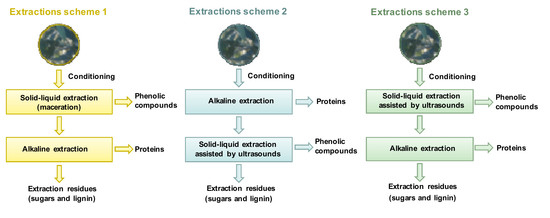Integrated Process for Sequential Extraction of Bioactive Phenolic Compounds and Proteins from Mill and Field Olive Leaves and Effects on the Lignocellulosic Profile
Abstract
1. Introduction
2. Materials and Methods
2.1. Chemicals and Standards
2.2. Samples
2.3. Chemical Composition of Leafy Byproducts and Extraction Residues
2.4. Ethanolic Extraction
2.5. Alkaline Extraction
2.6. Total Phenol Content (TPC) Method
2.7. Trolox Equivalent Antioxidant Capacity (TEAC) Assay
2.8. Reversed-Phase (RP)-HPLC Analyses
2.9. Protein Content
2.10. Sodium Dodecyl Sulphate (SDS)-Polyacrylamide Gel Electrophoresis (PAGE)
2.11. Sugar and Sugar Alcohol Analysis
2.12. Statistical Analysis
3. Results and Discussion
3.1. Raw Composition of Leafy Byproducts
3.2. Evaluation of the Extractions Schemes on Phenolic Compounds, Proteins, Sugars, and Lignin
3.2.1. Evaluation of the Extractions Schemes on Olive Mill Leaves
3.2.2. Comparison between Olive Mill Leaves and Olive Leaves from Field
3.3. Evaluation of the Solubilization of Proteins by Mild Alkaline Conditions after Phenolic Extraction
3.4. Evaluation of the Solubilization of Proteins by Strong Alkaline-thermal Conditions
3.5. Characterization of the Protein Products by SDS-PAGE
3.6. Characterization of the Residual Fraction after the Sequential Extraction of Phenolic Compounds and Protein
4. Conclusions
Supplementary Materials
Author Contributions
Funding
Acknowledgments
Conflicts of Interest
References
- FAOSTAT. Available online: http://www.fao.org/faostat/en/#data (accessed on 13 February 2019).
- Gullón, B.; Gullón, P.; Eibes, G.; Cara, C.; De Torres, A.; López-Linares, J.C.; Ruiz, E.; Castro, E. Valorisation of olive agro-industrial by-products as a source of bioactive compounds. Sci. Total Environ. 2018, 645, 533–542. [Google Scholar] [CrossRef] [PubMed]
- Romero-García, J.M.; Niño, L.; Martínez-Patiño, C.; Álvarez, C.; Castro, E.; Negro, M.J. Biorefinery based on olive biomass. State of the art and future trends. Bioresour. Technol. 2014, 159, 421–432. [Google Scholar] [CrossRef] [PubMed]
- Romero-García, J.M.; Lama-Muñoz, A.; Rodríguez-Gutiérrez, G.; Moya, M.; Ruiz, E.; Fernández-Bolaños, J.; Castro, E. Obtaining sugars and natural antioxidants from olive leaves by steam-explosion. Food Chem. 2016, 210, 457–465. [Google Scholar] [CrossRef]
- Talhaoui, N.; Taamalli, A.; Gómez-Caravaca, A.M.; Fernández-Gutiérrez, A.; Segura-Carretero, A. Phenolic compounds in olive leaves: Analytical determination, biotic and abiotic influence, and health benefits. Food Res. Int. 2015, 77, 92–108. [Google Scholar] [CrossRef]
- Ruiz, E.; Romero-García, J.M.; Romero, I.; Manzanares, P.; Negro, M.J.; Castro, E. Olive-derived biomass as a source of energy and chemicals. Biofuel. Bioprod. Biorefin. 2017, 11, 1077–1094. [Google Scholar] [CrossRef]
- Benavente-García, O.; Castillo, J.; Lorente, J.; Ortuño, A.; Del Rio, J.A. Antioxidant activity of phenolics extracted from Olea europea L. leaves. Food Chem. 2000, 68, 457–462. [Google Scholar] [CrossRef]
- Cavaca, L.A.S.; Alfonso, C.A.M. Oleuropein: A valuable bio-renewable synthetic building block. Eur. J. Org. Chem. 2018, 2018, 581–589. [Google Scholar] [CrossRef]
- Commission Regulation (EU) Nº 432/2012 of 16 May 2012 establishing a list of permitted health claims made on foods, other than those referring to the reduction of disease risk and to children’s development and health. Off. J. Eur. Union 2012, 136, 1–40.
- Ammar, S.; Kelebek, H.; Zribi, A.; Abichou, M.; Selli, S.; Bouaziz, M. LC-DAD/ESI-MS/MS characterization of phenolic constituents in Tunisian extra-virgin olive oils: Effect of olive leaves addition on chemical composition. Food Res. Int. 2017, 100, 477–485. [Google Scholar] [CrossRef]
- Mekky, R.H.; Abdel-Sattar, E.; Segura-Carretero, A.; Contreras, M.d.M. Phenolic Compounds from sesame cake and antioxidant activity: A new insight for agri-food residues’ significance for sustainable development. Foods 2019, 8, 432. [Google Scholar] [CrossRef]
- Solarte-Toro, J.C.; Romero-García, J.M.; Susmozas, A.; Ruiz, E.; Castro, E.; Cardona-Alzate, C.A. Techno-economic feasibility of bioethanol production via biorefinery of olive tree prunings (OTP): optimization of the pretreatment stage. Holzforschung 2019, 73, 3–13. [Google Scholar] [CrossRef]
- Contreras, M.d.M.; Lama-Muñoz, A.; Gutiérrez-Pérez, J.M.; Espínola, F.; Moya, M.; Castro, E. Protein extraction from agri-food residues for integration in biorefinery: Potential techniques and current status. Bioresour. Technol. 2019, 280, 459–477. [Google Scholar] [CrossRef] [PubMed]
- Fetzer, A.; Herfellner, T.; Stäbler, A.; Menner, M.; Eisner, P. Influence of process conditions during aqueous protein extraction upon yield from pre-pressed and cold-pressed rapeseed press cake. Ind. Crop. Prod. 2018, 112, 236–246. [Google Scholar] [CrossRef]
- Connolly, A.; Piggott, C.O.; Fitzgerald, R.J. Characterisation of protein-rich isolates and antioxidative phenolic extracts from pale and black brewers’ spent grain. Int. J. Food Sci. Technol. 2013, 48, 1670–1681. [Google Scholar] [CrossRef]
- Lei, X.G. Sustaining the future of animal feed protein. Ind. Biotechnol. 2018, 14, 74–76. [Google Scholar] [CrossRef]
- Determination of Structural Carbohydrates and Lignin in Biomass. Laboratory Analytical Procedure (LAP). Available online: https://www.nrel.gov/docs/gen/fy13/42618.pdf (accessed on 13 February 2019).
- Hatfield, R.; Fukushima, R.S. Can Lignin Be Accurately Measured? Crop Sci. 2005, 45, 832–839. [Google Scholar] [CrossRef]
- Ammar, S.; Contreras, M.d.M.; Gargouri, B.; Segura-Carretero, A.; Bouaziz, M. RP-HPLC-DAD-ESI-QTOF-MS based metabolic profiling of the potential Olea europaea by-product “wood” and its comparison with leaf counterpart. Phytochem. Anal. 2017, 28, 217–229. [Google Scholar] [CrossRef]
- Mekky, R.H.; Contreras, M.d.M.; Roshdi El-Gindi, M.; Abdel-Monem, A.R.; Abdel-Sattar, E.; Segura-Carretero, A. Profiling of phenolic and other compounds from Egyptian cultivars of chickpea (Cicer arietinum L.) and antioxidant activity: A comparative study. RSC Adv. 2015, 5, 17751–17767. [Google Scholar] [CrossRef]
- Determination of Biophenols in Olive Oils by HPLC. Available online: http://www.internationaloliveoil.org/documents/viewfile/4141-met29eng (accessed on 13 February 2019).
- Vergara-Barberán, M.; Lerma-García, M.J.; Herrero-Martínez, J.M.; Simó-Alfonso, E.F. Use of an enzyme-assisted method to improve protein extraction from olive leaves. Food Chem. 2015, 169, 28–33. [Google Scholar] [CrossRef]
- Martínez-Patiño, J.C.; Romero, I.; Ruiz, E.; Cara, C.; Romero-García, J.M.; Castro, E. Design and optimization of sulfuric acid pretreatment of extracted olive tree biomass using response surface methodology. BioResources 2017, 12, 1779–1797. [Google Scholar] [CrossRef]
- Zhao, X.; Liu, D. Chemical and thermal characteristics of lignins isolated from Siam weed stem by acetic acid and formic acid delignification. Ind. Crop. Prod. 2010, 32, 284–291. [Google Scholar] [CrossRef]
- Cara, C.; Ruiz, E.; Carvalheiro, F.; Moura, P.; Ballesteros, I.; Castro, E.; Gírio, F. Production, purification and characterisation of oligosaccharides from olive tree pruning autohydrolysis. Ind. Crop. Prod. 2012, 40, 225–231. [Google Scholar] [CrossRef]
- Scheller, H.V.; Ulvskov, P. Hemicelluloses. Annu. Rev. Plant Biol. 2010, 61, 263–289. [Google Scholar] [CrossRef] [PubMed]
- Galanakis, C.M.; Tornberg, E.; Gekas, V. Recovery and preservation of phenols from olive waste in ethanolic extracts. J. Chem. Technol. Biotechnol. 2010, 85, 1148–1155. [Google Scholar] [CrossRef]
- Roselló-Soto, E.; Galanakis, C.M.; Brnčić, M.; Orlien, V.; Trujillo, F.J.; Mawson, R.; Knoerzer, K.; Tiwari, B.K.; Barba, F.J. Clean recovery of antioxidant compounds from plant foods, byproducts and algae assisted by ultrasounds processing. Modeling approaches to optimize processing conditions. Trends Food Sci. Technol. 2015, 42, 134–149. [Google Scholar] [CrossRef]
- Stamatopoulos, K.; Katsoyannos, E.; Chatzilazarou, A. Antioxidant activity and thermal stability of oleuropein and related phenolic compounds of olive leaf extract after separation and concentration by salting-out-assisted cloud point extraction. Antioxidants 2014, 3, 229–244. [Google Scholar] [CrossRef]
- Soler-Rivas, C.; Espín, J.C.; Wichers, H.J. Oleuropein and related compounds. J. Sci. Food. Agric. 2000, 80, 1013–1023. [Google Scholar] [CrossRef]
- Bunzel, M.; Schendel, R.R. Determination of (Total) Phenolics and Antioxidant Capacity in Food and Ingredients. In Food Analysis, 5th ed.; Nielsen, S., Ed.; Springer Cham: New York, NY, USA, 2017; pp. 455–468. [Google Scholar]
- Karki, B.; Lamsal, B.P.; Jung, S.; van Leeuwen, J. (Hans); Pometto, A.L.; Grewell, D.; Khanal, S.K. Enhancing protein and sugar release from defatted soy flakes using ultrasound technology. J. Food Eng. 2010, 96, 270–278. [Google Scholar] [CrossRef]
- Jönsson, L.J.; Martín, C. Pretreatment of lignocellulose: Formation of inhibitory by-products and strategies for minimizing their effects. Bioresour. Technol. 2016, 199, 103–112. [Google Scholar] [CrossRef]
- Lama-Muñoz, A.; Contreras, M.d.M.; Espínola, F.; Moya, M.; Romero, I.; Castro, E. 1. Optimization of oleuropein and luteolin-7-O-glucoside extraction from olive leaves by ultrasound-assisted technology. Energies 2019, 12, 2486. [Google Scholar] [CrossRef]
- Salido, S.; Perez-Bonilla, M.; Adams, R.P.; Altarejos, J. Phenolic components and antioxidant activity of wood extracts from 10 main Spanish olive cultivars. J. Agric. Food Chem. 2015, 63, 6493–6500. [Google Scholar] [CrossRef] [PubMed]
- Sari, Y.W.; Mulder, W.J.; Sanders, J.P.M.; Bruins, M.E. Towards plant protein refinery: Review on protein extraction using alkali and potential enzymatic assistance. Biotechnol. J. 2015, 10, 1138–1157. [Google Scholar] [CrossRef] [PubMed]
- Sari, Y.W.; Syafitri, U.; Sanders, J.P.M.; Bruins, M.E. How biomass composition determines protein extractability. Ind. Crop. Prod. 2015, 70, 125–133. [Google Scholar] [CrossRef]
- Zhang, C.; Sanders, J.P.M.; Bruins, M.E. Critical parameters in cost-effective alkaline extraction for high protein yield from leaves. Biomass Bioenerg. 2014, 67, 466–472. [Google Scholar] [CrossRef]
- Lorenzo-Hernando, A.; Ruiz-Vegas, J.; Vega-Alegre, M.; Bolado-Rodríguez, S. Recovery of proteins from biomass grown in pig manure microalgae-based treatment plants by alkaline hydrolysis and acidic precipitation. Bioresour. Technol. 2019, 273, 599–607. [Google Scholar] [CrossRef]
- Zhang, C.; Sanders, J.P.M; Xiao, T.T.; Bruins, M.E. How does alkali aid protein extraction in green tea leaf residue: A basis for integrated biorefinery of leaves. PLoS ONE 2015, 10, e0133046. [Google Scholar] [CrossRef]
- Maayan, I.; Shaya, F.; Ratner, K.; Mani, Y.; Lavee, S.; Avidan, B.; Shahak, Y.; Ostersetzer-Biran, O. Photosynthetic activity during olive (Olea europaea) leaf development correlates with plastid biogenesis and Rubisco levels. Physiol. Plant. 2008, 134, 547–558. [Google Scholar] [CrossRef]
- Chen, Y.; Stevens, M.A.; Zhu, Y.; Holmes, J.; Xu, H. Understanding of alkaline pretreatment parameters for corn stover enzymatic saccharification. Biotechnol. Biofuels 2013, 6, 8. [Google Scholar] [CrossRef]
- Ponnusamy, V.K.; Nguyen, D.D.; Dharmaraja, J.; Shobana, S.; Banu, J.R.; Saratale, R.G.; Chang, S.W.; Kumar, G. A review on lignin structure, pretreatments, fermentation reactions and biorefinery potential. Bioresour. Technol. 2019, 271, 462–472. [Google Scholar] [CrossRef]
- Kim, J.S.; Lee, Y.Y.; Kim, T.H. A review on alkaline pretreatment technology for bioconversion of lignocellulosic biomass. Bioresour. Technol. 2016, 199, 42–48. [Google Scholar] [CrossRef]
- Tarasov, D.; Leitch, M.; Fatehi, P. Lignin–carbohydrate complexes: Properties, applications, analyses, and methods of extraction: A review. Biotechnol. Biofuels 2018, 11, 269. [Google Scholar] [CrossRef] [PubMed]
- Rencoret, J.; Gutiérrez, A.; Castro, E.; del Río, J.C. Structural characteristics of lignin in pruning residues of olive tree (Olea europaea L.). Holzforschung 2019, 73, 25–34. [Google Scholar] [CrossRef]
- McIntosh, S.; Vancov, T. Optimisation of dilute alkaline pretreatment for enzymatic saccharification of wheat straw. Biomass Bioenerg. 2011, 35, 3094–3103. [Google Scholar] [CrossRef]
- Rommi, K.; Niemi, P.; Kemppainen, K.; Kruus, K. Impact of thermochemical pre-treatment and carbohydrate and protein hydrolyzing enzyme treatment on fractionation of protein and lignin from brewer’s spent grain. J. Cereal Sci. 2018, 79, 168–173. [Google Scholar] [CrossRef]
- Arzamasov, A.A.; van Sinderen, D.; Rodionov, D.A. Comparative genomics reveals the regulatory complexity of bifidobacterial arabinose and arabino-oligosaccharide utilization. Front. Microbiol. 2018, 9, 776. [Google Scholar] [CrossRef]

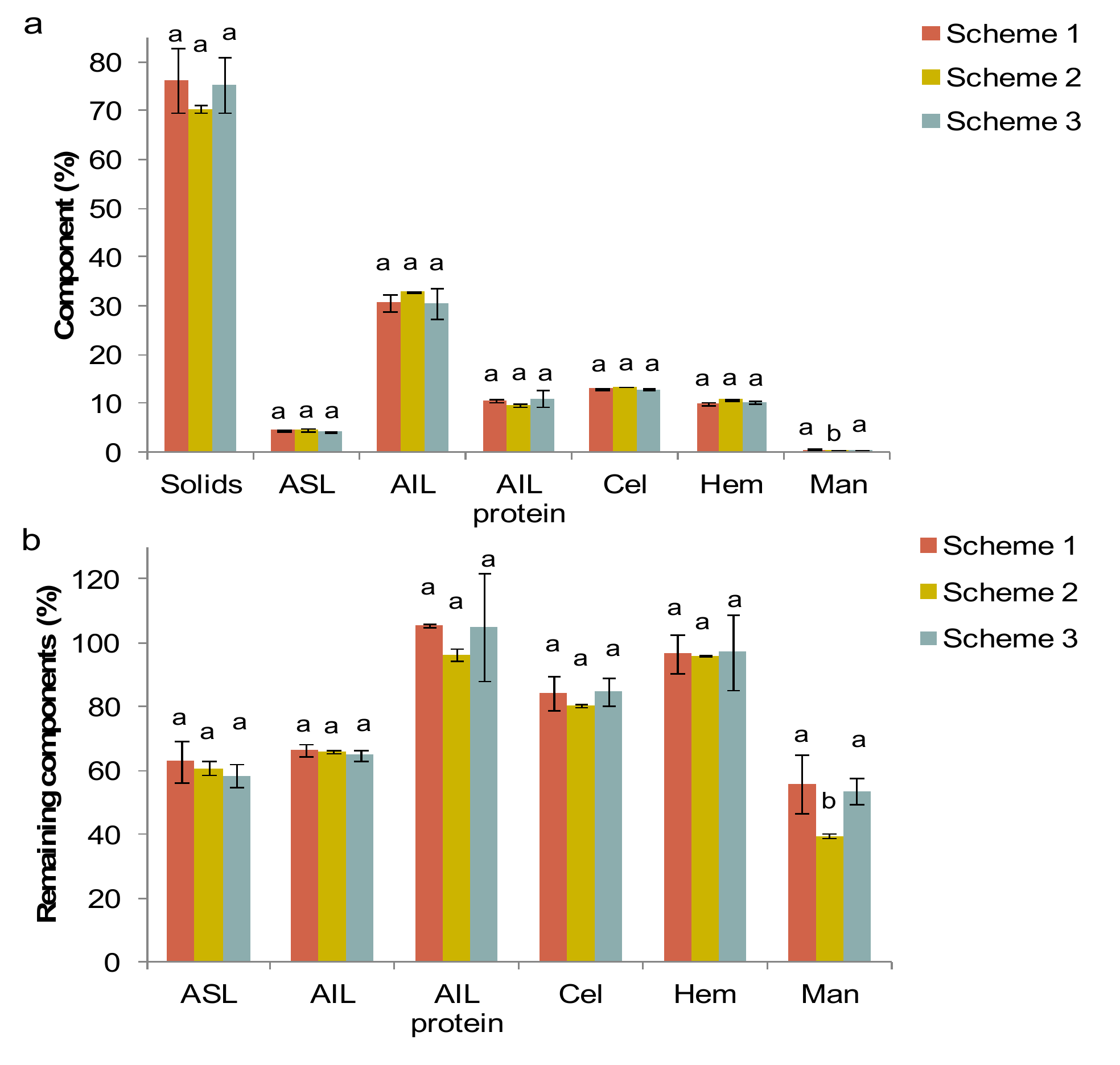
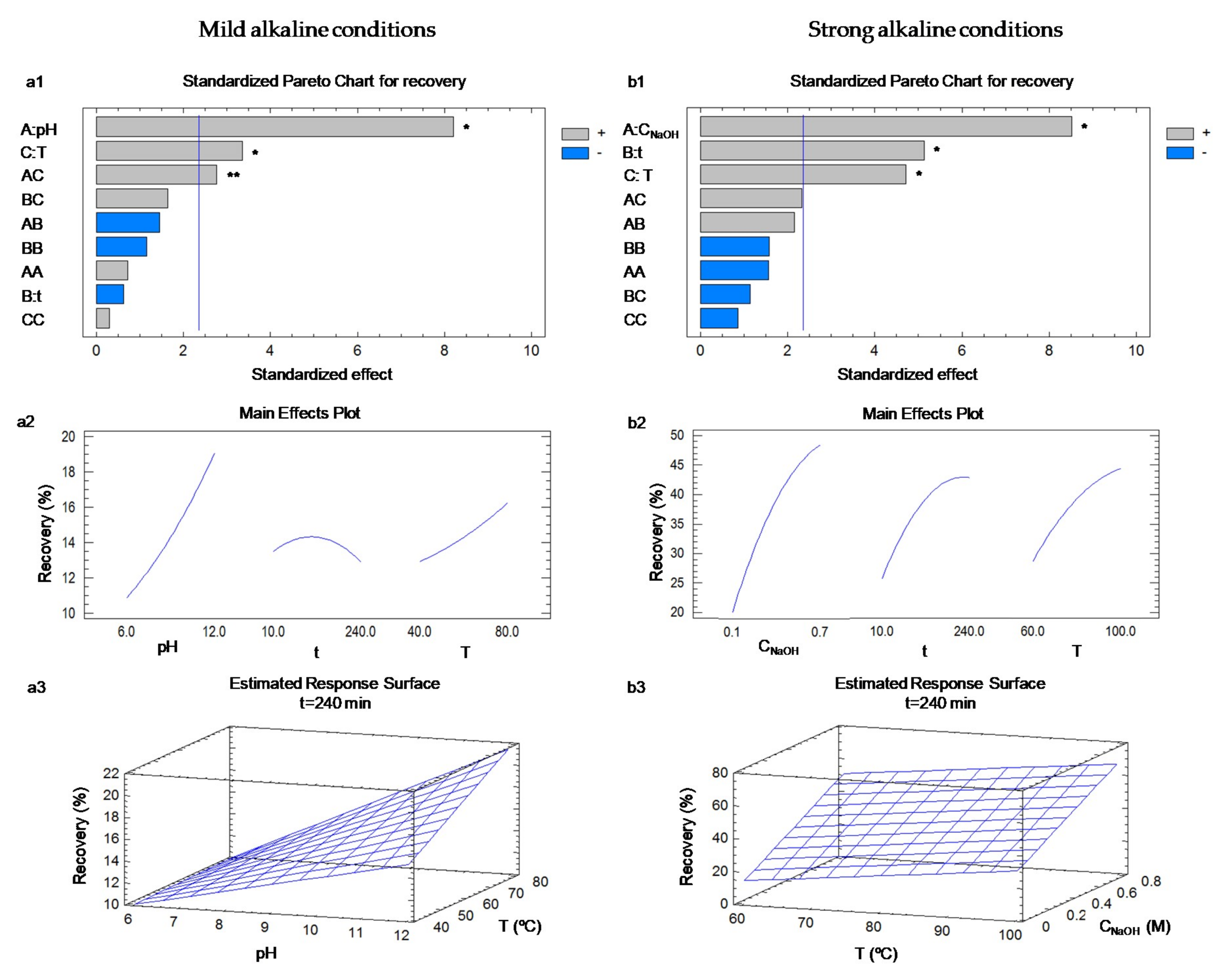
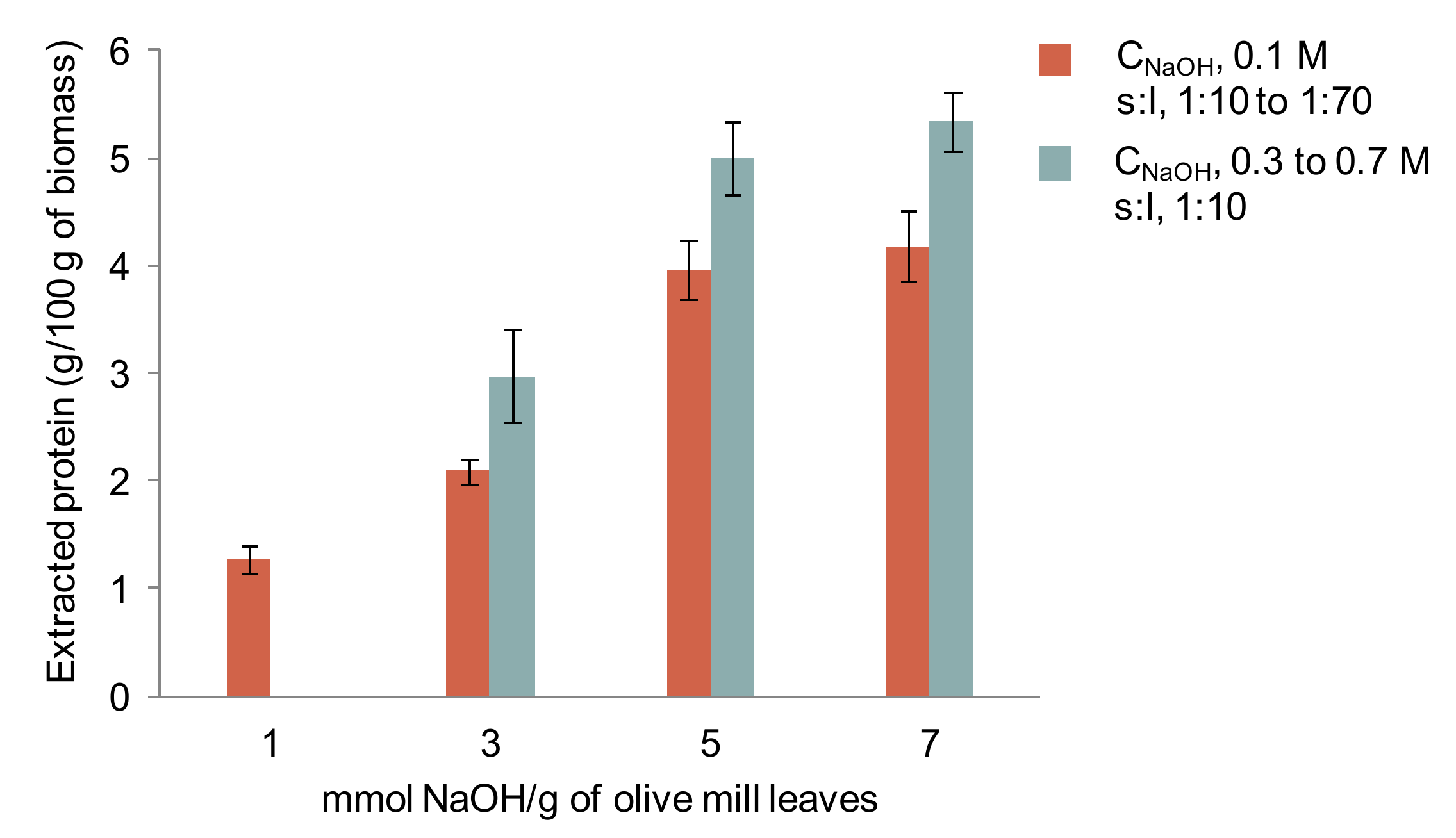
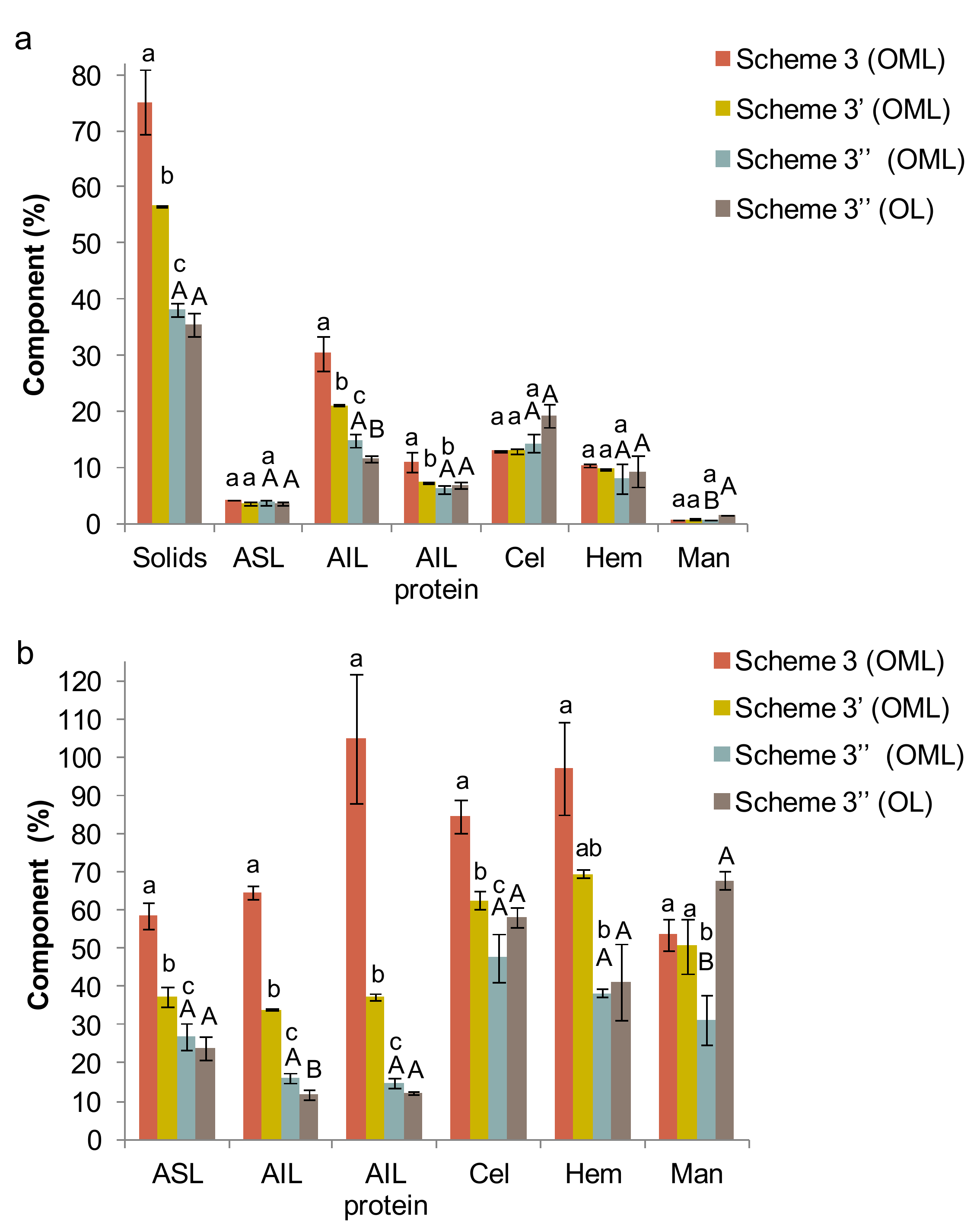
| Component (%) | OML | OL |
|---|---|---|
| Crude protein | 8.10 ± 0.38 1 | 9.34 ± 0.35 1 |
| Cellulose (as glucose) | 11.73 ± 0.14 1 | 15.84 ± 0.29 1 |
| Hemicellulose | 7.92 ± 0.05 1,2 | 8.62 ± 0.10 1,2 |
| Mannitol | 0.76 ± 0.02 1 | 2.81 ± 0.03 1 |
| Acid soluble lignin | 5.40 ± 0.09 1 | 7.46 ± 0.37 1 |
| Acid insoluble lignin | 35.16 ± 0.05 1,3 | 28.85 ± 1.05 1,3 |
| N in acid-insoluble lignin | 1.06 ± 0.11 1 | 0.82 ± 0.04 1 |
| Ash | 10.04 ± 0.08 1 | 6.24 ± 0.06 1 |
| Byproduct # | Scheme ‡ | Phenolic Yield | TPC/Biomass | TPC/Extract | Ole/Biomass | Ole/Extract | L7G/Biomass | L7G/Extract | TEAC #/Biomass | TEAC #/Extract | Protein Recovery |
|---|---|---|---|---|---|---|---|---|---|---|---|
| OML | 1 | 10.1 ± 0.2 b | 454 ± 36 b | 4476 ± 284 a | 142 ± 3 ab | 1395 ± 6 ab | 31 ± 4 ab | 309 ± 46 a | 2024 ± 2 b | 18,234 ± 139 b | 11.2 ± 0.8 a |
| OML | 2 | 11.7 ± 0.2 a | 719 ± 89 a | 6167 ± 847 a | 79 ± 0.3 b | 675 ± 6 b | 28 ± 0.3 b | 237 ± 6 b | 3087 ± 143 a | 25,459 ± 2809 a | 13.7 ± 1.4 a |
| OML | 3 | 11.7 ± 0.6 aA | 585 ± 24 abB | 4998 ± 65 aB | 191 ± 45 aB | 1790 ± 434 aB | 38 ± 3 aB | 338 ± 21 aB | 2193 ± 69 bB | 19,050 ± 101 bB | 12.5 ± 0.8 a |
| OL | 3 | 10.8 ± 0.8 A | 1405 ± 99 A | 13,108 ± 1877 A | 1365 ± 6 A | 12,694 ± 694 A | 97 ± 1 A | 903 ± 8 A | 6364 ± 38 A | 59,651 ± 6429 A | ND |
| Equation Terms | Mild Alkaline Conditions | Strong Alkaline Conditions |
|---|---|---|
| Coefficients 1 | ||
| a0 | 10.785 | −27.166 |
| Linear | ||
| a1 | −0.174 *** | 47.100 *** |
| a2 | NS | 0.074 ** |
| a3 | −0.147 ** | 0.392 ** |
| Interaction | ||
| a12 | NS | NS |
| a13 | 0.026 * | NS |
| a23 | NS | NS |
| Quadratic | ||
| a11 | NS | NS |
| a22 | NS | NS |
| a33 | NS | NS |
| R2 | 0.85 | 0.69 |
| Lack-of-fit | 0.823 | 0.113 |
| Optimum (estimated) | 22.3 | 62.7 |
| Optimum (experimental) | 21.7 ± 2.3 | 63.1 ± 5.7 |
| 1 (pH/CNaOH) | 12 | 0.7 M |
| 2 (time) | 240 min | 240 min |
| 3 (temperature) | 80 °C | 100 °C |
| Assay No. | pH | NaOH Concentration (M) | Time (min) | Temperature (°C) | Protein Recovery (%) | Yield (Solids) (%) |
|---|---|---|---|---|---|---|
| 1 | 13.2 | 0.4 | 125 | 80 | 36.1 | 40.0 |
| 2 | 13.6 | 0.7 | 240 | 60 | 43.4 | 57.4 |
| 3 | 13.5 | 0.7 | 240 | 100 | 55.8 | 66.5 |
| 4 | 12.2 | 0.1 | 240 | 100 | 15.5 | 24.4 |
| 5 | 12.3 | 0.1 | 240 | 60 | 14.4 | 23.4 |
| 6 | 12.2 | 0.1 | 10 | 100 | 13.6 | 23.2 |
| 7 | 13.3 | 0.4 | 10 | 80 | 13.6 | 32.1 |
| 8 | 13.4 | 0.4 | 125 | 80 | 38.4 | 42.2 |
| 9 | 13.1 | 0.7 | 10 | 60 | 17.1 | 50.3 |
| 10 | 13.7 | 0.7 | 125 | 80 | 51.3 | 60.1 |
| 11 | 12.5 | 0.1 | 10 | 60 | 10.0 | 39.2 |
| 12 | 12.7 | 0.1 | 125 | 80 | 16.7 | 21.2 |
| 13 | 12.7 | 0.4 | 125 | 100 | 53.5 | 50.0 |
| 14 | 13.2 | 0.7 | 10 | 100 | 43.9 | 63.3 |
| 15 | 13.3 | 0.4 | 125 | 80 | 36.8 | 42.6 |
| 16 | 13.4 | 0.4 | 240 | 80 | 54.3 | 49.3 |
| 17 | 12.8 | 0.4 | 125 | 60 | 19.0 | 41.6 |
| 18 | 13.2 | 0.4 | 125 | 80 | 50.9 | 46.1 |
© 2019 by the authors. Licensee MDPI, Basel, Switzerland. This article is an open access article distributed under the terms and conditions of the Creative Commons Attribution (CC BY) license (http://creativecommons.org/licenses/by/4.0/).
Share and Cite
Contreras, M.d.M.; Lama-Muñoz, A.; Gutiérrez-Pérez, J.M.; Espínola, F.; Moya, M.; Romero, I.; Castro, E. Integrated Process for Sequential Extraction of Bioactive Phenolic Compounds and Proteins from Mill and Field Olive Leaves and Effects on the Lignocellulosic Profile. Foods 2019, 8, 531. https://doi.org/10.3390/foods8110531
Contreras MdM, Lama-Muñoz A, Gutiérrez-Pérez JM, Espínola F, Moya M, Romero I, Castro E. Integrated Process for Sequential Extraction of Bioactive Phenolic Compounds and Proteins from Mill and Field Olive Leaves and Effects on the Lignocellulosic Profile. Foods. 2019; 8(11):531. https://doi.org/10.3390/foods8110531
Chicago/Turabian StyleContreras, María del Mar, Antonio Lama-Muñoz, José Manuel Gutiérrez-Pérez, Francisco Espínola, Manuel Moya, Inmaculada Romero, and Eulogio Castro. 2019. "Integrated Process for Sequential Extraction of Bioactive Phenolic Compounds and Proteins from Mill and Field Olive Leaves and Effects on the Lignocellulosic Profile" Foods 8, no. 11: 531. https://doi.org/10.3390/foods8110531
APA StyleContreras, M. d. M., Lama-Muñoz, A., Gutiérrez-Pérez, J. M., Espínola, F., Moya, M., Romero, I., & Castro, E. (2019). Integrated Process for Sequential Extraction of Bioactive Phenolic Compounds and Proteins from Mill and Field Olive Leaves and Effects on the Lignocellulosic Profile. Foods, 8(11), 531. https://doi.org/10.3390/foods8110531






